Fashion / Calendar, 23 July 2022
Kimono Style: The John C. Weber Collection
Exhibition on the transformation of Kimono fashion from the late 18th to the early 20th Century
opens at The Metropolitan Museum of Art
7 June 2022-February 20, 2023

Installation view of Kimono Style: The John C. Weber Collection, on view June7, 2022–February 20, 2023 at The Metropolitan Museum of Art, New York. Photo by Bruce Schwarz, Courtesy of The Met
Düsseldorf, 23 July 2022: The pieces in the John C. Weber Collection explore the artistic exchange between the kimono and Western fashion. On display are more than 60 kimonos, as well as Western couture and Japanese art.
The diversity of kimono trends reveals much about Japanese culture and society. Textile techniques reached their peak during the Edo period (1615-1868). Members of the ruling military class, the samurais, were the main consumers of kimonos, each of which was custom-made. At the same time, an urban culture developed and the merchant class used their wealth to afford the luxury of a kimono.
Later, the art of the kimono was to have a lasting influence on Western fashion. Fashion designers such as Madeleine Vionnet, Poiret and Cristóbal Balenciaga drew inspiration for their creations from the construction of a kimono.
During the Meiji period (1868-1912), Western clothing was introduced to Japan. At the same time, the modernisation of society allowed more women to have access to silk kimonos. In the 1920s, affordable off-the-rack (meisen) kimonos became very popular, reflecting a more Western lifestyle. They were sold in department stores modelled on Western retailers.
------
Düsseldorf, 23. Juli 2022: Die Stücke der John C. Weber Collection erforschen den künstlerischen Austausch zwischen dem Kimono und der westlichen Mode. Gezeigt werden mehr als 60 Kimonos, sowie westliche Couture und japanische Kunst.
Die Vielfalt der Kimono Trends verraten viel über die japanische Kultur und Gesellschaft. Die Textiltechniken erreichten während der Edo-Periode (1615-1868) ihren Höhepunkt. Die Mitglieder der herrschenden Militärklasse, die Samurais, waren die Hauptabnehmer der Kimonos, von denen jeder nach massangefertigt wurde. Gleichzeitig entwickelte sich eine städtische Kultur, und die Kaufmannsschicht nutzte ihren Reichtum, um sich den Luxus eines Kimono zu leisten.
Später sollte die Kunst des Kimonos die westliche Mode nachhaltig beeinflussen. Modeschöpfer wie Madeleine Vionnet, Poiret und Cristóbal Balenciaga ließen sich von der Konstruktion eines Kimonos zu ihren Kreationen inspirieren.
In der Meiji-Zeit (1868-1912) wurde die westliche Kleidung in Japan eingeführt. Gleichzeitig ermöglichten die Modernisierung der Gesellschaft mehr Frauen den Zugang zu Seidenkimonos. In den 1920er Jahren wurden erschwingliche Kimonos von der Stange (Meisen) sehr beliebt und spiegelten einen westlicheren Lebensstil wider. Sie wurden in Kaufhäusern verkauft, die westlichen Einzelhändlern nachempfunden waren.
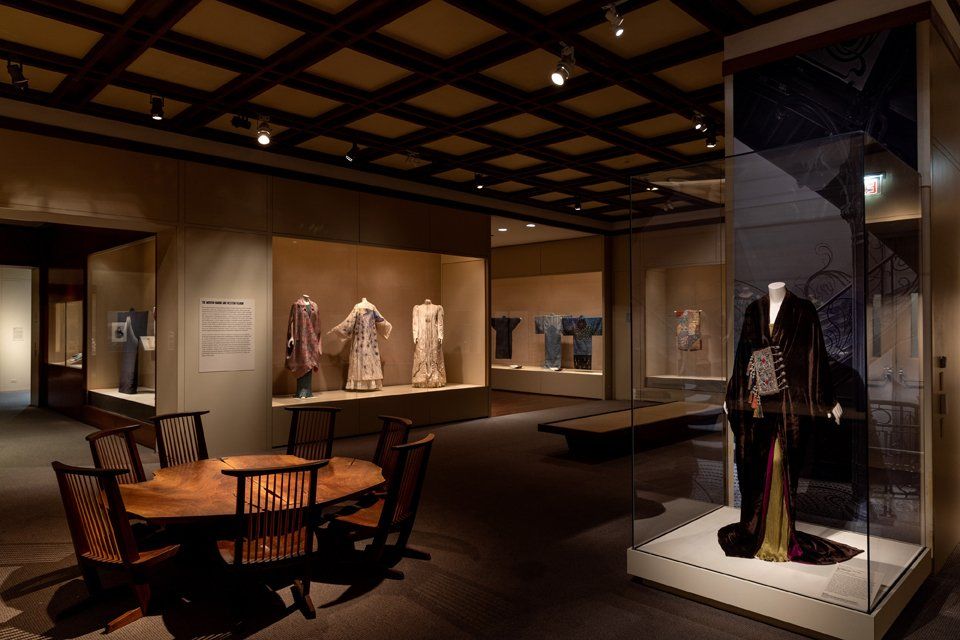
Creation by Poiret
Installation view of Kimono Style: The John C. Weber Collection, on view June7, 2022–February 20, 2023 at The Metropolitan Museum of Art, New York. Photo by Bruce Schwarz, Courtesy of The Met
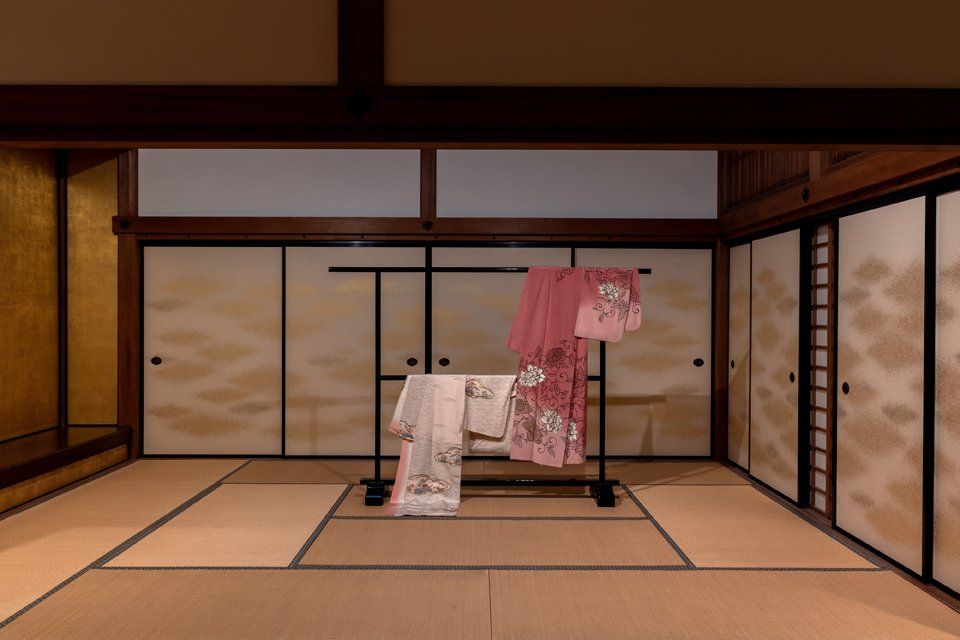
Installation view of Kimono Style: The John C. Weber Collection, on view June7, 2022–February 20, 2023 at The Metropolitan Museum of Art, New York. Photo by Bruce Schwarz, Courtesy of The Met

Installation view of Kimono Style: The John C. Weber Collection, on view June7, 2022–February 20, 2023 at The Metropolitan Museum of Art, New York. Photo by Bruce Schwarz, Courtesy of The Met
Overview of the exhibition
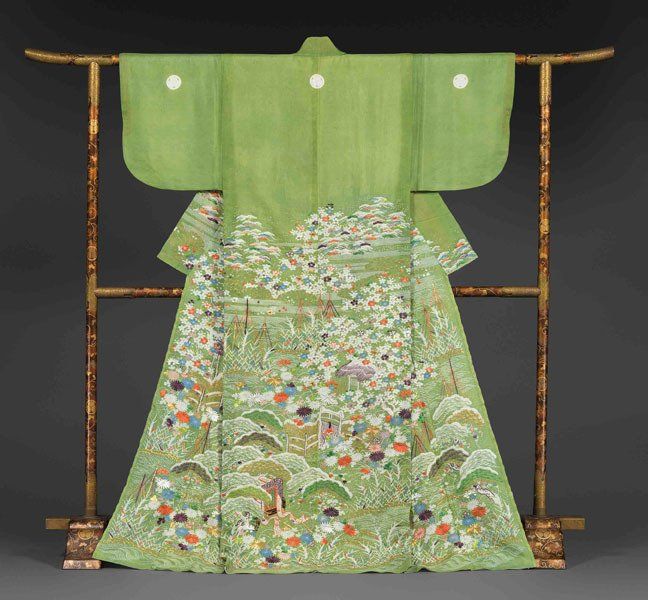
Summer robe (hito-e) with court carriage and waterside scene. Edo period (1615–1868), early 19th century. Gauze-weave silk with stencil paste-resist dyeing, stencil-dyed dots (suri-bitta), hand-painted details, silk embroidery, and couched gold thread. 72 3/4 x 48 3/4 in. (184.6 x 123.8 cm). John C. Weber Collection.
Image © The Metropolitan Museum of Art, photo by Paul Lachenauer
Edo period (1615-1868)
During the Edo period (1615-1868), society was controlled by the Tokugawa shogunate military government and clothing could not be freely chosen. At the top of the social hierarchy were the samurai. On rare official occasions, the women of the samurai elite wore finely crafted silk robes, such as the summer robe (hito-e) with a court carriage and a scene by the water from the late Edo period, which was made for a woman of the Tokugawa shogunate family.
Edo-Periode (1615-1868)
Während der Edo-Periode (1615-1868) wurde die Gesellschaft durch die Militärregierung Tokugawa-Shogunat kontrolliert und Kleidung konnte nicht frei gewählt werden. An der Spitze der sozialen Hierarchie standen die Samurai. Bei den seltenen offiziellen Anlässen trugen die Frauen der Samurai-Elite fein gearbeitete Seidengewänder, wie das Sommergewand (hito-e) mit einer Hofkutsche und einer Szene am Wasser aus der späten Edo-Periode, das für eine Frau der Tokugawa-Shogun-Familie angefertigt wurde.

Fireman’s jacket (hikeshi-banten) with Shogun Tarō Yoshikado. Edo period (1615–1868), mid-19th century.
Quilted cotton with tube-drawn paste-resist dyeing (tsutsugaki) with hand-painted details. 36 x 49 in. (91.4 x 124.5 cm). John C. Weber Collection.
Image © The Metropolitan Museum of Art, photo by Paul Lachenauer
Battles Surcoat fireman
Auch Feuerwehrleute genossen in Japan Respekt, insbesondere in Edo (dem heutigen Tokio), wo die Holzarchitektur zu häufigen Feuerausbrüchen führte. Samurai-Feuerwehrmänner trugen teure Gewänder aus importierter Wolle. Die Mäntel der Stadtbewohner waren wendbar und bestanden aus dicker, gesteppter Baumwolle mit einer einfarbigen, indigo-gefärbten Außenseite und einer verzierten Innenseite, auf der in der Regel Kriegerhelden und Fabelwesen abgebildet waren.
Schlachten Surcoat Feuerwehrmann
Auch Feuerwehrleute genossen in Japan Respekt, insbesondere in Edo (dem heutigen Tokio), wo die Holzarchitektur zu häufigen Feuerausbrüchen führte. Samurai-Feuerwehrmänner trugen teure Gewänder aus importierter Wolle. Die Mäntel der Stadtbewohner waren wendbar und bestanden aus dicker, gesteppter Baumwolle mit einer einfarbigen, indigo-gefärbten Außenseite und einer verzierten Innenseite, auf der in der Regel Kriegerhelden und Fabelwesen abgebildet waren.

Battle surcoat (jinbaori) with tattered fan. Edo period (1615–1868), early 19th century. Wool (rasha). 34 1/2 x 28 1/2 in. (87.6 x 72.4 cm). John C. Weber Collection.
Image © The Metropolitan Museum of Art, photo by Paul Lachenauer
Jinbaori, battle coats
High-ranking samurai had access to the finest materials, including wool imported from Europe, and they used decorated battle coats (jinbaori) to demonstrate their status. Later, jinbaori were developed into ceremonial garments, such as the battle coat with a tattered fan.
Jinbaori, Kampfmäntel
Hochrangige Samurai hatten Zugang zu den feinsten Materialien, einschließlich aus Europa importierter Wolle, und sie nutzten verzierte Kampfmäntel (jinbaori), um ihren Status zu demonstrieren. Später wurden Jinbaori zu zeremoniellen Kleidungsstücken entwickelten, wie z. B. der Kampfmantel mit zerfetztem Fächer.

Installation view of Kimono Style: The John C. Weber Collection, on view June7, 2022–February 20, 2023 at The Metropolitan Museum of Art, New York. Photo by Bruce Schwarz, Courtesy of The Met

Man’s under kimono (nagajuban) with Mount Fuji. Shōwa period (1926–89), second quarter 20th century. Plain-weave silk with stitched tie-dyeing. 53 9/16 × 52 3/4 in. (136 × 134 cm). Promised Gift of John C. Weber. Image © The Metropolitan Museum of Art, photo by Paul Lachenauer

“Paris”coat, Paul Poiret (French, Paris 1879–1944 Paris).1919. Silk, wool, metallic thread.
The Metropolitan Museum of Art, Purchase, Friends of The Costume Institute Gifts, 2005 (2005.207).
Image©The Metropolitan Museum of Art
The 20th century in Japan
The 20th century saw an increasing orientation towards Western art trends, including the Art Nouveau style and the geometric forms of Art Deco.
At the same time, Western fashion designers took their cues from Japanese art and clothing. Fashion designers such as Parisian innovators Paul Poiret, Callot Soeurs and Madeleine Vionnet abandoned the S-shaped, corset bodice in favour of a flat, modern line.
Poiret's modernist "Paris" coat of 1919 was made from a single 15-foot-long piece of silk velvet with minimal cutting, evoking the concept of making a kimono from a single piece of fabric with no waste and only straightforward elements.
Das 20. Jahrhundert in Japan
Das 20. Jahrhundert orientierte sich zunehmend an westlichen Kunstströmungen, darunter der Stil des Jugendstils und die geometrischen Formen des Art Déco.
Gleichzeitig orientierten sich die westlichen Modeschöpfer an der japanischen Kunst und Kleidung. Modeschöpfer, wie die Pariser Innovatoren Paul Poiret, Callot Soeurs und Madeleine Vionnet gaben das S-förmige, korsettierte Mieder zugunsten einer flachen, modernen Linie auf.
Poirets modernistischer "Paris"-Mantel von 1919 wurde aus einem einzigen, 15 Fuß langen Stück Seidensamt mit minimalem Zuschnitt gefertigt und erinnerte an das Konzept, einen Kimono aus einem einzigen Stück Stoff ohne Verschnitt und nur mit geradlinigen Elementen herzustellen.

Meisen kimono with large checkered pattern. Shōwa period (1926–89), ca. 1930s. Plain-weave machine-spun silk in resist-dyed large ikat (ōgasuri) with gold-thread weft. 57 x 47 in. (144.8 x 119.4 cm). Promised Gift of John C. Weber.
Image © The Metropolitan Museum of Art, photo by Paul Lachenauer
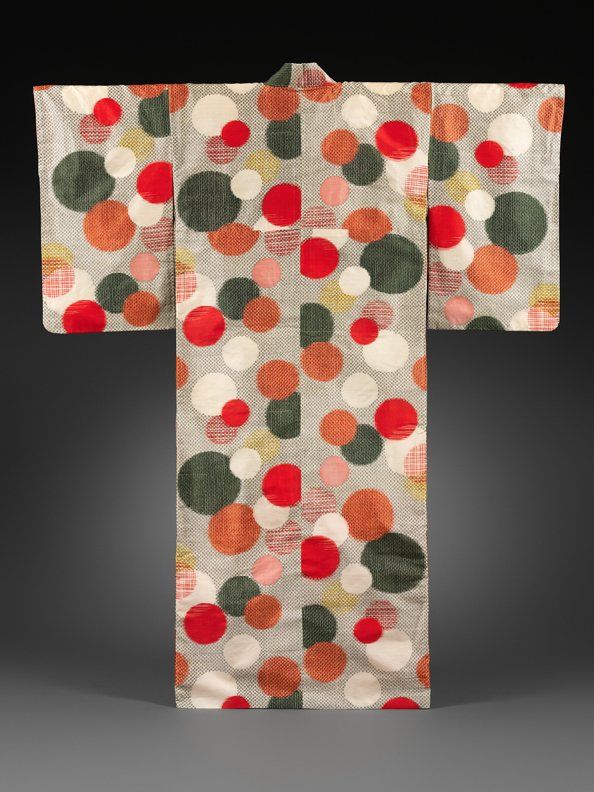
Meisen kimono with water droplets. Shōwa period (1926–89), ca. 1930–40. Plain-weave reeled-silk warps with machine-spun silk wefts in double ikat (heiyō-gasuri). 59 x 49 1/4 in. (149.9 x 125.1 cm). Promised Gift of John C. Weber.
Image © The Metropolitan Museum of Art, photo by Paul Lachenauer
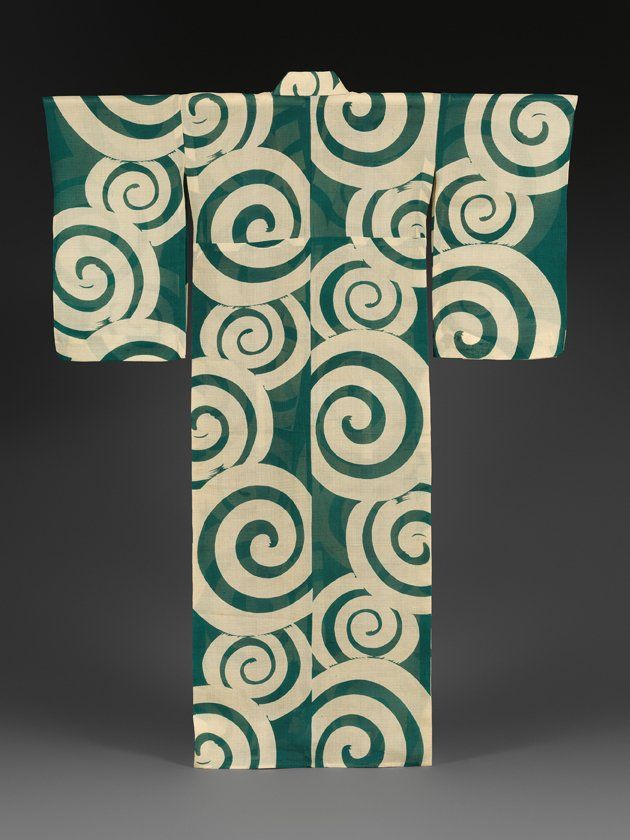
Summer kimono (hito-e) with swirls. Taishō (1912–26)–Shōwa period (1926–89), 1920s–30s. Printed gauze-weave (Nero) silk with twisted wefts. 60 13/16 × 45 in. (154.5 × 114.3 cm). Promised Gift of John C. Weber.
Image © The Metropolitan Museum of Art, photo by Paul
Lachenauer

Installation view of Kimono Style: The John C. Weber Collection, on view June7, 2022–February 20, 2023 at The Metropolitan Museum of Art, New York. Photo by Bruce Schwarz, Courtesy of The Met
Kimonos from Meisen, 1920s and 1930s
Affordable kimonos were made from Meisen, an inexpensive silk woven from pre-dyed yarns; a technique known as ikat (kasuri). In the 1920s and 1930s, working and middle class women could buy these colourful, modern kimonos with vibrant graphic patterns. Many of the patterns of the Meisen kimonos were inspired by avant-garde art movements such as Italian Futurism and Dutch "De Stijl". The compositions of Piet Mondrian were particularly influential, as shown by a large ikat (ōgasuri) kimono in bright yellow, petrol and raspberry red.
Kimonos aus Meisen, 1920er und 1930er Jahren
Erschwingliche Kimonos wurden aus Meisen gefertigt, einer preiswerten Seide, die aus vorgefärbten Garnen gewebt wurde; eine Technik, die als Ikat (kasuri) bekannt ist. In den 1920er und 1930er Jahren konnten Frauen aus der Arbeiter- und Mittelschicht diese farbenfrohen, modernen Kimonos mit lebhaften grafischen Mustern kaufen. Viele Muster der Meisen-Kimonos wurden von avantgardistischen Kunstbewegungen wie dem italienischen Futurismus und dem niederländischen "De Stijl" inspiriert. Besonders einflussreich waren die Kompositionen von Piet Mondrian, wie ein großer ikat (ōgasuri) Kimono in leuchtendem Gelb, Petrol und Himbeerrot zeigt.

Coat, Yohji Yamamoto (Japanese, born Tokyo, 1943). Spring/summer 1983. Cotton. The Metropolitan Museum of Art, Purchase, Gould Family Foundation Gift, in memory of Jo Copeland, 2011 (2011.288).
Image © The Metropolitan Museum of Art

Evening wrap, House of Balenciaga (French, founded 1937), Cristobal Balenciaga (Spanish, 1895–1972). 1951. Silk. The Metropolitan Museum of Art, Gift of Baroness Philippe de Rothschild, 1973 (1973.21.3).
Image © The Metropolitan Museum of Art

Installation view of Kimono Style: The John C. Weber Collection, on view June7, 2022–February 20, 2023 at The Metropolitan Museum of Art, New York. Photo by Bruce Schwarz, Courtesy of The Met
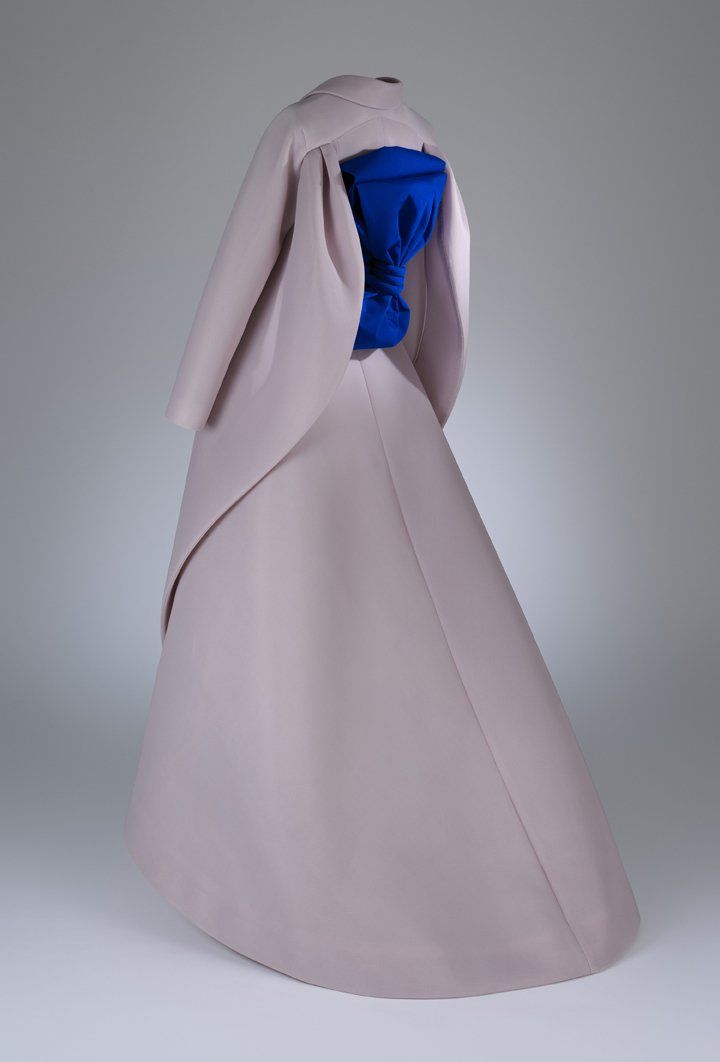
Coat dress, Maison Margiela (French, founded 1988). John Galliano (British, born Gibraltar, 1960). Fall/winter 2015–16, Artisanal. Polyester, cotton. The Metropolitan Museum of Art, Gift of Maison Margiela, in honor of Harold Koda, 2016 (2016.401a–c).
Image © The Metropolitan Museum of Art

Coat dress, Maison Margiela
Installation view of Kimono Style: The John C. Weber Collection, on view June7, 2022–February 20, 2023 at The Metropolitan Museum of Art, New York. Photo by Bruce Schwarz, Courtesy of The Met

Coat, Comme des Garçons (Japanese, founded 1969). Rei Kawakubo (Japanese, born 1942). Spring/summer 2018. Polyester, nylon. The Metropolitan Museum of Art, Purchase, Various Donors, by exchange, 2018 (2018.650a–c).N
Image © The Metropolitan Museum of Art

"UKIYOE," Hanae Mori (Japanese, born 1926). Fall/winter 1983–84. Silk, glass. The Metropolitan Museum of Art, Gift of Hanae Mori, 2004 (2004.467.4)
Image © The Metropolitan Museum of Art

Coat, Comme des Garçons
Installation view of Kimono Style: The John C. Weber Collection, on view June7, 2022–February 20, 2023 at The Metropolitan Museum of Art, New York. Photo by Bruce Schwarz, Courtesy of The Met
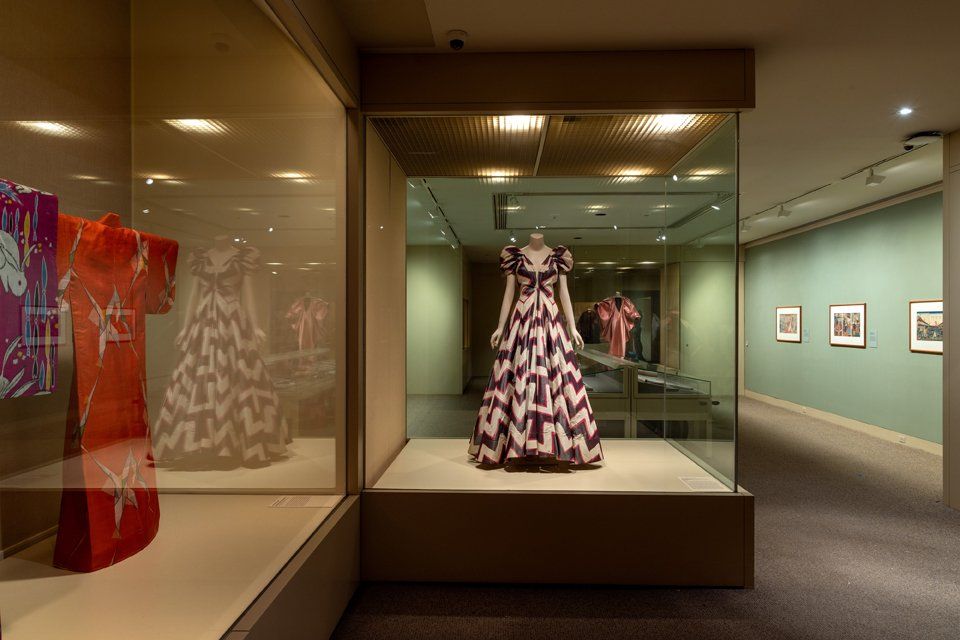
Installation view of Kimono Style: The John C. Weber Collection, on view June7, 2022–February 20, 2023 at The Metropolitan Museum of Art, New York. Photo by Bruce Schwarz, Courtesy of The Met
The kimono as a source of inspiration
Since the second half of the 20th century, the iconic structure of the kimono has been a source of inspiration for both Japanese and Western fashion. Some contemporary designers use the shape of the kimono as a starting point for architecturally constructed garments, such as the work of Issey Miyake and Cristobal Balenciaga.
From Japanese designers working in the West, such as Yohji Yamamoto and Rei Kawakubo, the kimono dynamically reflects Japanese culture both to the world and back on itself.
Through all these iterations, the kimono has hinted at a future beyond fashion trends, cultural boundaries and gender norms.
Der Kimono als Inspirationsquelle
Seit der zweiten Hälfte des 20. Jahrhunderts ist die ikonische Struktur des Kimonos eine Inspirationsquelle sowohl für die japanische als auch für die westliche Mode. Einige zeitgenössische Designer nutzen die Form des Kimonos als Ausgangspunkt für architektonisch konstruierte Kleidungsstücke, wie die Arbeiten von Issey Miyake und Cristobal Balenciaga.
Von japanischen Designern, die im Westen tätig sind, wie Yohji Yamamoto und Rei Kawakubo, spiegelt der Kimono die japanische Kultur dynamisch sowohl in die Welt als auch auf sich selbst zurück.
Durch all diese Iterationen hat der Kimono eine Zukunft jenseits von Modetrends, kulturellen Grenzen und Geschlechternormen angedeutet.
Alethea Magazine - Fashion / Calendar, 23 July 2022
Kimono Style: The John C. Weber Collection
Exhibition on the transformation of Kimono fashion from the late 18th to the early 20th Century
opens at The Metropolitan Museum of Art
7 June 2022-February 20, 2023
Where to see:
The Met Fifth Avenue,
Art from Japan,
Galleries 223-232
#MetKimonos
Source: Metcommunications
ALETHEA recommends:
23 July 2022
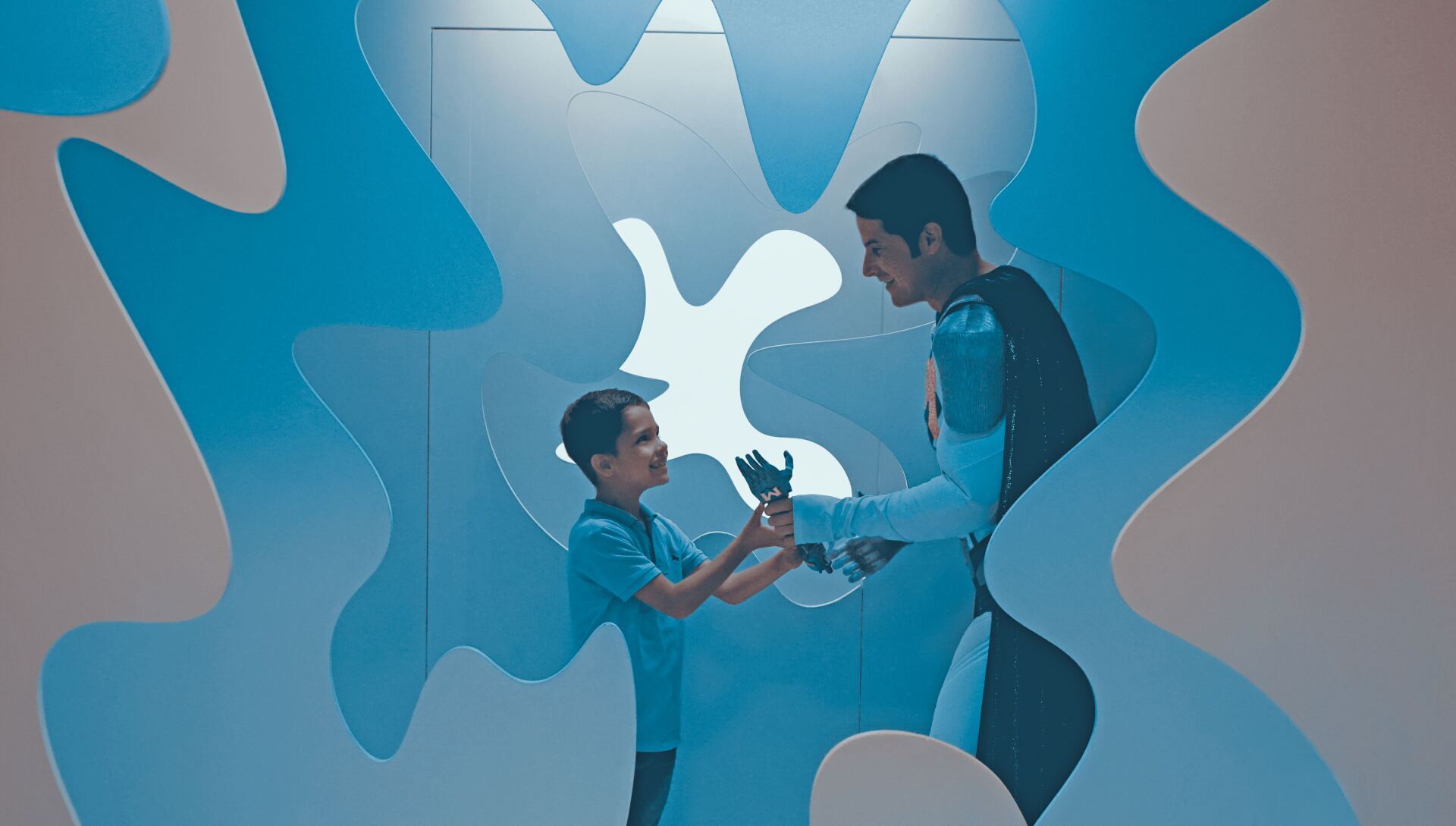
Personalities - 15 July 2022
Interview with Michel Fornasier, "When weakness becomes a superpower." Michel Fornasier, founder of the Give CHILDREN a Hand Foundation, was born without a right hand. He has been embodying the superhero for 5 years to teach children tolerance and respect for diversity. If he succeeds in getting his audience to turn their weaknesses into a strength, then his mission is accomplished. Why this approach is also important for adults, you can find out in the personal interview.

©Michel Fornasier
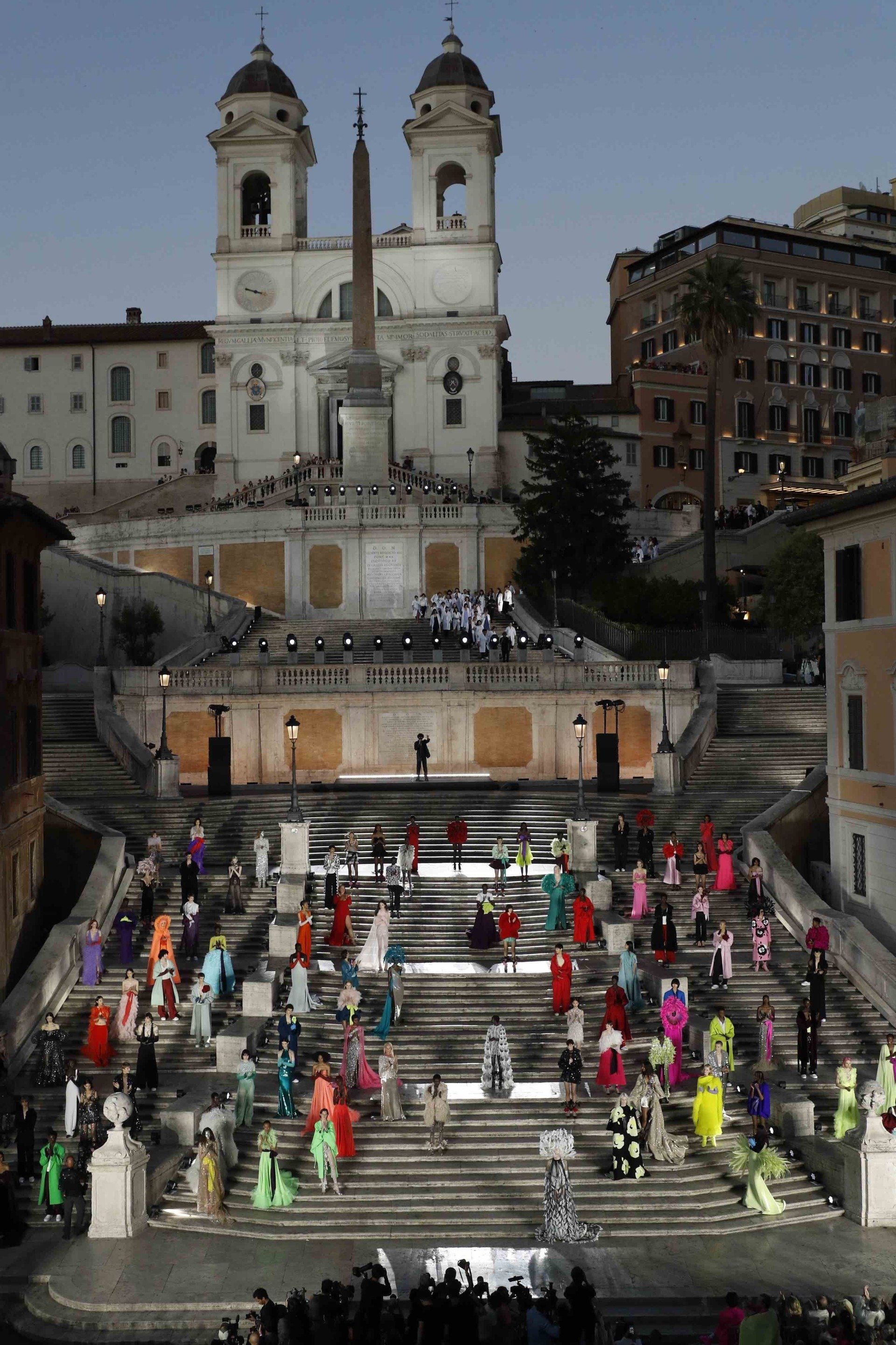
10 July 2022 Fashion / Art
Maison Valentino The Beginning Haute Couture FW 22 23 - 8 July 2022 Spanish Steps in Rome. "Beauty comes from harmony" says Pierpaolo Piccioli, referring also to the harmony of society. The magic hour began when the sun set on the Spanish Steps on 8 July 2022, bathing the houses in a golden light. Valentino beings strode down the Spanish Steps and went to the historic Valentino Atelier in Piazza Mignanelli. The concept: Pierpaolo Piccioli wants to bring the people and ideas that were once on the margins into focus, to make them protagonists. An idea that expands the spectrum of beauty.
©Valentino

Art Calendar / Art, 21 July 2022
"Michael Kagan: It Lasts Forever", Almine Rech, London. "Iconic moments that change the future in a split second".
Michael Kagan dedicates his work to explorers from mountaineers to astronauts. In his characteristically thick brushstrokes, he depicts people pushing the limits of nature through physical endurance and technology. He has already been invited to SpaceX. Elon Musk now owns a painting of his, as does NASA astronaut Leland Melvin. An exclusive interview.
Michael Kagan Communication Immage 2022 ©Michael Kagan

Michael Kagan Installation view Argl 2022 ©Melissa Castro Duarte

Art Calendar - 18 July 2022
Message of the Kaiadilt Culture, Sally Gabori. The Fondation Cartier pour l'art contemporain presents the first major solo exhibition of Aboriginal artist Mirdidingkingathi Juwarnda Sally Gabori outside Australia from 3 July to 6 November 2022. The exhibition and archive sallygabori-fondationcartier.com is a unique testament to Australian Kaiadilt culture.
Sally Gabori, Mornington Island Arts and Crafts Centre, 2008-2012.
© The Estate of Sally Gabori.
Photo © Inge Cooper


